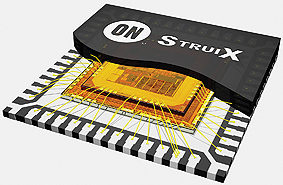ON Semiconductor has responded to rapidly-evolving product development demands within the portable medical market by introducing Struix, a semi-customisable System-in-Package

(SiP) solution for precision sensing and monitoring in a variety of mobile medical electronics including glucose monitors, heart rate monitors and electrocardiogram analysers.
Struix, which means “stacked” in Latin, utilizes advanced die stacking technology to integrate a custom-designed analogue front-end (AFE) on top of an industry-leading 32-bit Application Specific Standard Product (ASSP) microcontroller (ULPMC10), to form a complete miniature system. By using standard and customisable components, Struix offers medical device manufacturers the design flexibility required to create unique medical sensor interface applications while improving time-to-market and cost-effectiveness.
The ULPMC10 microcontroller element of Struix processes signals using an industry-leading 32-bit ARM® Cortex®-M3 core capable of running up to frequencies of 30 megahertz (MHz). The microcontroller incorporates 512 kilobytes (kB) on-chip Flash memory and 24 kB SRAM memory to store critical program and user data. Designed to improve battery life in portable devices, ULPMC10 offers superior performance with minimal dynamic and static power demands. Through on-chip charge pump-based power conversion and regulation, the microcontroller can operate at a current consumption of less than 200 µA/MHz. While in standby mode, current consumption remains below 500 nanoamperes (nA), a critical parameter for low-duty cycle medical devices.
The system’s advanced power management subsystem monitors the device for fail-safe operation with a wide variety of battery voltages without requiring external components. The microcontroller also includes a12-bit analogue-to-digital converter with three multiplexed inputs, a real-time clock, a phase-locked-loop, and a temperature sensor. To simplify product development, ON Semiconductor offers a comprehensive and easy-to-use suite of development add-ins for IAR Systems to support the ULPMC10 microcontroller, including CMSIS based software interfaces.
Using ON Semiconductor’s custom chip engagement model, medical device manufacturers can take advantage of an extensive portfolio of intellectual property and design experience to meet the stringent feature and performance- level requirements of medical sensor applications.
ON Semiconductor
www.onsemi.com


